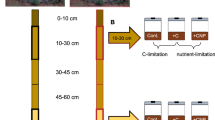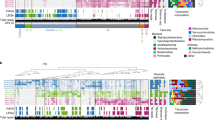Abstract
Identifying soil microbial feedbacks to increasing temperatures and moisture alterations is critical for predicting how terrestrial ecosystems will respond to climate change. We performed a 5-year field experiment manipulating warming, watering and their combination in a semiarid temperate steppe in northern China. Warming stimulated the abundance of genes responsible for degrading recalcitrant soil organic matter (SOM) and reduced SOM content by 13%. Watering, and warming plus watering also increased the abundance of recalcitrant SOM catabolism pathways, but concurrently promoted plant growth and increased labile SOM content, which somewhat offset SOM loss. The treatments also increased microbial biomass, community complexity and metabolic potential for nitrogen and sulfur assimilation. Both microbial and plant community composition shifted with the treatment conditions, and the sample-to-sample compositional variations of the two communities (pairwise β-diversity distances) were significantly correlated. In particular, microbial community composition was substantially correlated with the dominant plant species (~0.54 Spearman correlation coefficient), much more than with measured soil indices, affirming a tight coupling between both biological communities. Collectively, our study revealed the direction and underlying mechanisms of microbial feedbacks to warming and suggested that semiarid regions of northern steppes could act as a net carbon source under increased temperatures, unless precipitation increases concurrently.
Similar content being viewed by others
Log in or create a free account to read this content
Gain free access to this article, as well as selected content from this journal and more on nature.com
or
References
Anderson MJ . (2003) PCO: a FORTRAN computer program for principal coordinate analysis. Department of Statistics, University of Auckland: New Zealand.
Anderson MJ . (2005) PERMANOVA: a FORTRAN Computer Program for Permutational Multivariate Analysis of Variance. Department of Statistics, University of Auckland: New Zealand.
Bao SD . (2000) Soil and Agricultural Chemistry Analysis. China Agriculture Press: Beijing, China.
Benjamini Y, Hochberg Y . (1995). Controlling the false discovery rate - a practical and powerful approach to multiple testing. J R Statist Soc B 57: 289–300.
Bray JR, Curtis JT . (1957). An ordination of the upland forest communities of southern Wisconsin. Ecol Monogr 27: 325–349.
Christensen L, Coughenour MB, Ellis JE, Chen Z . (2004). Vulnerability of the Asian typical steppe to grazing and climatic change. Climatic Change 63: 351–368.
Clarke KR, Ainsworth M . (1993). A method of linking multivariate community structure to environmental variables. Mar Ecol Prog Ser 92: 205–219.
Curtis TP, Sloan WT, Scannell JW . (2002). Estimating prokaryotic diversity and its limits. Proc Natl Acad Sci USA 99: 10494–10499.
DeSantis TZ, Hugenholtz P, Larsen N, Rojas M, Brodie EL, Keller K et al. (2006). Greengenes, a chimera-checked 16 S rRNA gene database and workbench compatible with ARB. Appl Environ Microbiol 72: 5069–5072.
Dore MHI . (2005). Climatic change and changes in global precipitation patterns: what do we know? Environ Int 31: 1167–1181.
Fierer N, Leff JW, Adams BJ, Nielsen UN, Bates ST, Lauber CL et al. (2012). Cross-biome metagenomic analyses of soil microbial communities and their functional attributes. Proc Natl Acad Sci USA 109: 21390–21395.
Ge Y, He J, Zhu Y, Zhang J, Xu Z, Zhang L et al. (2008). Differences in soil bacterial diversity: driven by contemporary disturbances or historical contingencies? ISME J 2: 254–264.
Groisman PY, Knight RW, Easterling DR, Karl TR, Hegerl GC, Razuvaev VN . (2005). Trends in intense precipitation in the climate record. J Climate 18: 1326–1350.
Grosse G, Harden J, Turetsky M, McGuire AD, Camill P, Tarnocai C et al. (2011). Vulnerability of high-latitude soil organic carbon in North America to disturbance. J Geophys Res 116: G00K06.
Handelsman J, Tiedje J, Alvarez-Cohen L, Ashburner M, Cann IKO, DeLong EE et al. (2007) The New Science of Metagenomics: Revealing the Secrets of Our Microbial Planet. The National Academies Press: Washington, DC, USA.
Heimann M, Reichstein M . (2008). Terrestrial ecosystem carbon dynamics and climate feedbacks. Nature 451: 289–292.
Intergovernmental Panel on Climate Change (IPCC).. (2014) Climate Change 2014: Impacts, Adaptation, and Vulnerability. Cambridge University Press: Cambridge, UK.
Karhu K, Auffret MD, Dungait JA, Hopkins DW, Prosser JI, Singh BK et al. (2014). Temperature sensitivity of soil respiration rates enhanced by microbial community response. Nature 513: 81–84.
Liu W, Zhang Z, Wan S . (2009). Predominant role of water in regulating soil and microbial respiration and their responses to climate change in a semiarid grassland. Glob Change Biol 15: 184–195.
Love MI, Huber W, Anders S . (2014). Moderated estimation of fold change and dispersion for RNA-seq data with DESeq2. Genome Biol 15: 550.
Lozupone C, Hamady M, Kelley ST, Knight R . (2007). Quantitative and qualitative β diversity measures lead to different insights into factors that structure microbial communities. Appl Environ Microbiol 73: 1576–1585.
Luo C, Rodriguez-R LM, Johnston ER, Wu L, Cheng L, Xue K et al. (2014). Soil microbial community responses to a decade of warming as revealed by comparative metagenomics. Appl Environ Microbiol 80: 1777–1786.
Lützow MV, Kögel-Knabner I, Ekschmitt K, Matzner E, Guggenberger G, Marschner B et al. (2006). Stabilization of organic matter in temperate soils: mechanisms and their relevance under different soil conditions – a review. Eur J Soil Sci 57: 426–445.
Mackelprang R, Waldrop MP, DeAngelis KM, David MM, Chavarria KL, Blazewicz SJ et al. (2011). Metagenomic analysis of a permafrost microbial community reveals a rapid response to thaw. Nature 480: 368–371.
McCalley CK, Woodcroft BJ, Hodgkins SB, Wehr RA, Kim E, Mondav R et al. (2014). Methane dynamics regulated by microbial community response to permafrost thaw. Nature 514: 478–481.
Mikutta R, Kleber M, Torn MS, Jahn R . (2006). Stabilization of soil organic matter: association with minerals or chemical recalcitrance? Biogeochemistry 77: 25–56.
Nie M, Pendall E, Bell C, Gasch CK, Raut S, Tamang S et al. (2012). Positive climate feedbacks of soil microbial communities in a semiarid grassland. Ecol Lett 16: 234–241.
Niu S, Wu M, Han Y, Xia J, Li L, Wan S . (2008). Water-mediated responses of ecosystem C fluxes to climatic change in a temperate steppe. New Phytol 177: 209–219.
Ondov BD, Treangen TJ, Mallonee AB, Bergman NH, Koren S, Phillippy AM . (2015). Fast genome and metagenome distance estimation using MinHash. bioRxiv doi:http://dx.doi.org/10.1101/029827.
Petersen DG, Blazewicz SJ, Firestone M, Herman DJ, Turetsky M, Waldrop M . (2012). Abundance of microbial genes associated with nitrogen cycling as indices of biogeochemical process rates across a vegetation gradient in Alaska. Environ Microbiol 14: 993–1008.
Quast C, Pruesse E, Yilmaz P, Gerken J, Schweer T, Yarza P et al. (2013). The SILVA ribosomal RNA gene database project: improved data processing and web-based tools. Nucl Acids Res 41: D590–D596.
Ramette A, Tiedje JM . (2007). Multiscale responses of microbial life to spatial distance and environmental heterogeneity in a patchy ecosystem. Proc Natl Acad Sci USA 104: 2761–2766.
Rodriguez-R LM, Konstantinidis KT . (2014). Estimating coverage in metagenomic data sets and why it matters. ISME J 8: 2349–2351.
Salles JF, Le Roux X, Poly F . (2012). Relating phylogenetic and functional diversity among denitrifiers and quantifying their capacity to predict community functioning. Front Microbiol 3: 209.
Scharlemann JPW, Tanner EVJ, Hiederer R, Kapos V . (2014). Global soil carbon: understanding and managing the largest terrestrial carbon pool. Carbon Manage 5: 81–91.
Singh BK, Quince C, Macdonald CA, Khachane A, Thomas N, Al-Soud WA et al. (2014). Loss of microbial diversity in soils is coincident with reductions in some specialized functions. Environ Microbiol 16: 2408–2420.
Song B, Niu S, Zhang Z, Yang H, Li L, Wan S . (2012). Light and heavy fractions of soil organic matter in response to climate warming and increased precipitation in a temperate steppe. PLoS One 7: e33217.
Steinauer K, Tilman D, Wragg PD, Cesarz S, Cowles JM, Pritsch K et al. (2015). Plant diversity effects on soil microbial functions and enzymes are stronger than warming in a grassland experiment. Ecology 96: 99–112.
Sun Y, Ding Y . (2010). A projection of future changes in summer precipitation and monsoon in East Asia. Sci China Earth Sci 53: 284–300.
Trivedi P, Delgado-Baquerizo M, Trivedi C, Hu H, Anderson IC, Jeffries TC et al. (2016). Microbial regulation of the soil carbon cycle: evidence from gene–enzyme relationships. ISME J 10: 2593–2604.
Wang X, Van Nostrand JD, Deng Y, Lü X, Wang C, Zhou J et al. (2015). Scale-dependent effects of climate and geographic distance on bacterial diversity patterns across northern China’s grasslands. FEMS Microbiol Ecol 91: doi: 10.1093/femsec/fiv133.
Yang H, Wu M, Liu W, Zhang Z, Zhang N, Wan S . (2011). Community structure and composition in response to climate change in a temperate steppe. Glob Change Biol 17: 452–465.
Zhang N, Liu W, Yang H, Yu X, Gutknecht JLM, Zhang Z et al. (2013c). Soil microbial responses to warming and increased precipitation and their implications for ecosystem C cycling. Oecologia 173: 1125–1142.
Zhang X, Barberán A, Zhu X, Zhang G, Han X . (2014). Water content differences have stronger effects than plant functional groups on soil bacteria in a steppe ecosystem. PLoS One 9: e115798.
Zhang X, Liu W, Schloter M, Zhang G, Chen Q, Huang J et al. (2013a). Response of the abundance of key soil microbial nitrogen-cycling genes to multi-factorial global changes. PLoS One 8: e76500.
Zhang X, Zhang G, Chen Q, Han X . (2013b). Soil bacterial communities respond to climate changes in a temperate steppe. PLoS One 8: e78616.
Zhou J, Xue K, Xie J, Deng Y, Wu L, Cheng X et al. (2012). Microbial mediation of carbon cycle feedbacks to climate warming. Nature Clim Change 2: 106–110.
Zhou X, Chen C, Wang Y, Xu Z, Han H, Li L et al. (2013). Warming and increased precipitation have differential effects on soil extracellular enzyme activities in a temperate grassland. Sci Total Environ 444: 552–558.
Acknowledgements
We thank professors Shiqiang Wan, Quansheng Chen, Wenming Bai and many others for setting up the experiment; Yi Ren, Qiuping Hu and many others in Shanghai Majorbio Bio-pharm Technology Co., Ltd. for help in sequencing. This research was supported by the Strategic Priority Research Program of CAS (XDB15010404) of China, and by the US Department of Energy (award DE-SC0004601). We also thank three anonymous reviewers for helpful suggestions.
Author information
Authors and Affiliations
Corresponding authors
Ethics declarations
Competing interests
The authors declare no conflict of interest.
Additional information
Supplementary Information accompanies this paper on The ISME Journal website
Supplementary information
Rights and permissions
About this article
Cite this article
Zhang, X., Johnston, E., Li, L. et al. Experimental warming reveals positive feedbacks to climate change in the Eurasian Steppe. ISME J 11, 885–895 (2017). https://doi.org/10.1038/ismej.2016.180
Received:
Revised:
Accepted:
Published:
Issue date:
DOI: https://doi.org/10.1038/ismej.2016.180
This article is cited by
-
Importance of plant community composition and aboveground biomass in shaping microbial communities following long-term nitrogen and phosphorus addition in a temperate steppe ecosystem
Plant and Soil (2025)
-
Effects of warming on soil fungal community and its function in a temperate steppe
Ecological Processes (2024)
-
Nitrogen deposition experiment mimicked with NH4NO3 overestimates the effect on soil microbial community composition and functional potential in the Eurasian steppe
Environmental Microbiome (2022)
-
Assessment of microbial α-diversity in one meter squared topsoil
Soil Ecology Letters (2022)
-
Specific patterns and drivers of the bacterial communities in the sediment of two typical integrated multitrophic aquaculture systems
Aquaculture International (2022)



